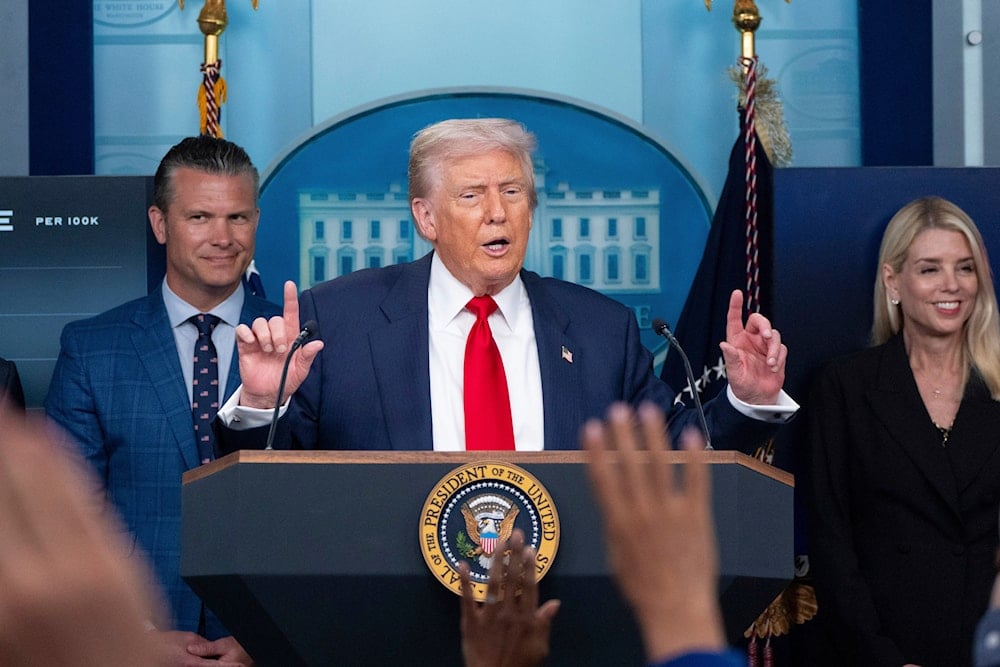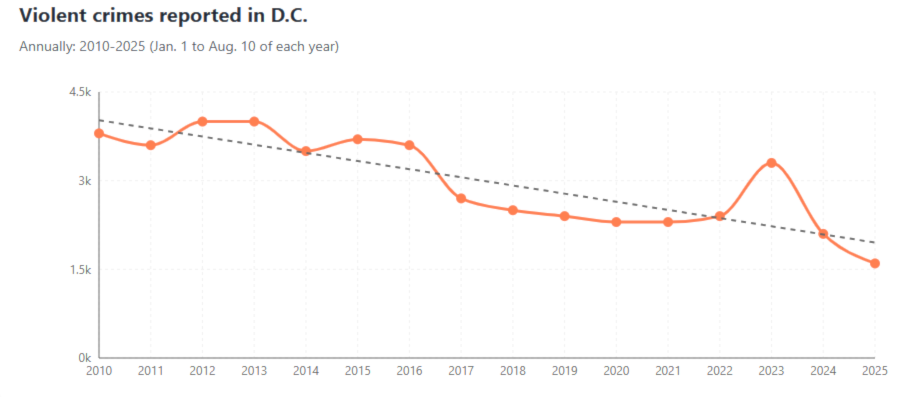Trump’s DC crime lie fits an old pattern of statistics disinformation
US President Donald Trump’s false claims regarding crimes in DC reflect a broader pattern of distorting statistics on crime, the economy, immigration, and more to push his political agenda.
-

US President Donald Trump speaks with reporters in the James Brady Press Briefing Room at the White House in Washington, as Secretary of Defense Pete Hegseth, left, and Attorney General Pam Bondi look on August 11, 2025. (AP Photo/Alex Brandon, File)
US President Donald Trump claimed this week that violent crime in Washington, DC is rising, using the assertion to declare a "crime emergency," take control of the city’s police force, and deploy the National Guard.
However, official data tells a very different story. According to the Justice Department, violent crime in DC hit a 30-year low in 2024, dropping 35% from the 2023 spike. The Major Cities Chiefs Association reports that in the first half of 2025, violent crime has fallen across all categories, 26% lower than the same period last year. For example, carjackings are down 37%, homicides have dropped 12% year-over-year, and there have been 98 homicides in 2025 so far, way below the city’s peak in the early 1990s.
-

Violent crimes reported in DC (source: Metropolitan Police Department; visual: Al Mayadeen English)
Despite these figures, Trump told reporters that "murders in 2023 reached the highest rate probably ever," ignoring the downward trend since then. While it is true that 2023 saw a 26-year high with 274 homicides, crime has since declined significantly.
DC Mayor Muriel Bowser, speaking alongside US Attorney Jeanine Pirro in a press conference, emphasized ongoing efforts to curb youth crime through targeted policing and extended curfews. Bowser rejected the idea that falling crime rates should lead to complacency, saying, "There’s nobody here who wants to tolerate any level of crime… we work every day to stop crime."
Trump's playbook of rejecting unfavorable data
Trump’s DC crime remarks are not an isolated incident, as they fit a longstanding pattern of rejecting official statistics when they contradict his political agenda.
Throughout his political career, Trump has dismissed credible crime data, calling FBI reports "fake numbers" when they showed national violent crime dropping 5.7% between 2022 and 2023, including a 13.2% decline in murders. Instead, he promoted the idea of a nationwide "migrant crime wave," unsupported by the evidence.
This tactic mirrors his approach in 2016, when he labeled the official unemployment rate as "phony numbers" and claimed it was 42%, nearly nine times the real figure. Once in office, his administration embraced the same labor statistics he had previously attacked.
Manipulating numbers across policy areas
The pattern extends well beyond crime data. In the economic sphere, after disappointing July 2025 jobs numbers, Trump fired the Bureau of Labor Statistics commissioner and baselessly claimed the figures were "rigged," while also exaggerating GDP growth projections and inflating trade deficit numbers far beyond official statistics.
On immigration, he has asserted that "more than 10 million" undocumented immigrants entered under Biden, double the actual figure reported by the Department of Homeland Security. His manipulation also extended to public health information during the COVID-19 pandemic, when his administration pressured the CDC to alter reports, downplayed testing, and promoted ineffective treatments.
In the environmental arena, Trump’s team removed the National Climate Assessment website and dismissed climate experts, an action scientists have described as "climate erasure."
Moreover, scholarly research shows that Trump’s repetition of false statistics reinforces public misperceptions, particularly among supporters exposed to partisan media. The Washington Post (WP) documented over 30,000 false or misleading claims during his first presidency, with the rate accelerating in the final months of 2020.
By undermining trusted data sources and promoting his own "alternative facts," Trump has created a parallel numerical reality that serves his political goals but distorts public understanding. His statements on DC crime are just the latest example of a broader strategy that uses false statistics as a tool of governance.

 4 Min Read
4 Min Read










